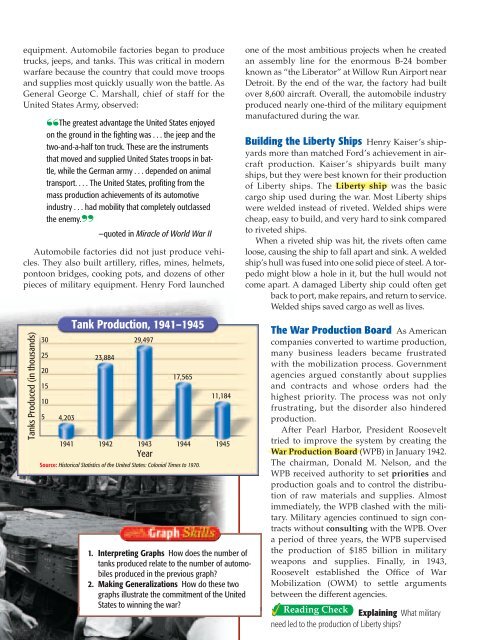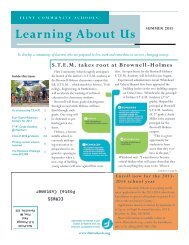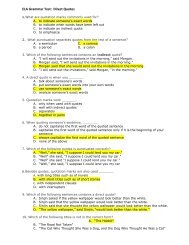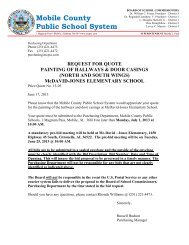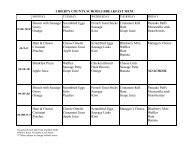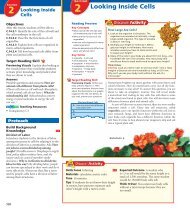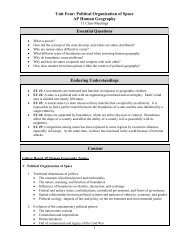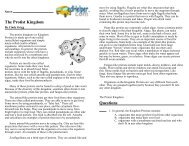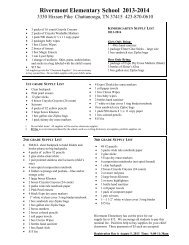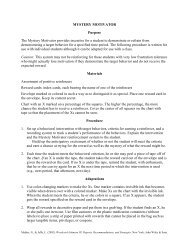Chapter 12: America and World War II, 1941-1945 - Georgia ...
Chapter 12: America and World War II, 1941-1945 - Georgia ...
Chapter 12: America and World War II, 1941-1945 - Georgia ...
You also want an ePaper? Increase the reach of your titles
YUMPU automatically turns print PDFs into web optimized ePapers that Google loves.
equipment. Automobile factories began to produce<br />
trucks, jeeps, <strong>and</strong> tanks. This was critical in modern<br />
warfare because the country that could move troops<br />
<strong>and</strong> supplies most quickly usually won the battle. As<br />
General George C. Marshall, chief of staff for the<br />
United States Army, observed:<br />
The greatest advantage the United States enjoyed<br />
“<br />
on the ground in the fighting was . . . the jeep <strong>and</strong> the<br />
two-<strong>and</strong>-a-half ton truck. These are the instruments<br />
that moved <strong>and</strong> supplied United States troops in battle,<br />
while the German army . . . depended on animal<br />
transport. . . . The United States, profiting from the<br />
mass production achievements of its automotive<br />
industry . . . had mobility that completely outclassed<br />
the enemy.<br />
”<br />
—quoted in Miracle of <strong>World</strong> <strong>War</strong> <strong>II</strong><br />
Automobile factories did not just produce vehicles.<br />
They also built artillery, rifles, mines, helmets,<br />
pontoon bridges, cooking pots, <strong>and</strong> dozens of other<br />
pieces of military equipment. Henry Ford launched<br />
Tanks Produced (in thous<strong>and</strong>s)<br />
30<br />
25<br />
20<br />
15<br />
10<br />
5<br />
4,203<br />
Tank Production, <strong>1941</strong>–<strong>1945</strong><br />
23,884<br />
29,497<br />
17,565<br />
11,184<br />
<strong>1941</strong> 1942 1943 1944 <strong>1945</strong><br />
Year<br />
Source: Historical Statistics of the United States: Colonial Times to 1970.<br />
1. Interpreting Graphs How does the number of<br />
tanks produced relate to the number of automobiles<br />
produced in the previous graph?<br />
2. Making Generalizations How do these two<br />
graphs illustrate the commitment of the United<br />
States to winning the war?<br />
one of the most ambitious projects when he created<br />
an assembly line for the enormous B-24 bomber<br />
known as “the Liberator” at Willow Run Airport near<br />
Detroit. By the end of the war, the factory had built<br />
over 8,600 aircraft. Overall, the automobile industry<br />
produced nearly one-third of the military equipment<br />
manufactured during the war.<br />
Building the Liberty Ships Henry Kaiser’s shipyards<br />
more than matched Ford’s achievement in aircraft<br />
production. Kaiser’s shipyards built many<br />
ships, but they were best known for their production<br />
of Liberty ships. The Liberty ship was the basic<br />
cargo ship used during the war. Most Liberty ships<br />
were welded instead of riveted. Welded ships were<br />
cheap, easy to build, <strong>and</strong> very hard to sink compared<br />
to riveted ships.<br />
When a riveted ship was hit, the rivets often came<br />
loose, causing the ship to fall apart <strong>and</strong> sink. A welded<br />
ship’s hull was fused into one solid piece of steel. A torpedo<br />
might blow a hole in it, but the hull would not<br />
come apart. A damaged Liberty ship could often get<br />
back to port, make repairs, <strong>and</strong> return to service.<br />
Welded ships saved cargo as well as lives.<br />
The <strong>War</strong> Production Board As <strong>America</strong>n<br />
companies converted to wartime production,<br />
many business leaders became frustrated<br />
with the mobilization process. Government<br />
agencies argued constantly about supplies<br />
<strong>and</strong> contracts <strong>and</strong> whose orders had the<br />
highest priority. The process was not only<br />
frustrating, but the disorder also hindered<br />
production.<br />
After Pearl Harbor, President Roosevelt<br />
tried to improve the system by creating the<br />
<strong>War</strong> Production Board (WPB) in January 1942.<br />
The chairman, Donald M. Nelson, <strong>and</strong> the<br />
WPB received authority to set priorities <strong>and</strong><br />
production goals <strong>and</strong> to control the distribution<br />
of raw materials <strong>and</strong> supplies. Almost<br />
immediately, the WPB clashed with the military.<br />
Military agencies continued to sign contracts<br />
without consulting with the WPB. Over<br />
a period of three years, the WPB supervised<br />
the production of $185 billion in military<br />
weapons <strong>and</strong> supplies. Finally, in 1943,<br />
Roosevelt established the Office of <strong>War</strong><br />
Mobilization (OWM) to settle arguments<br />
between the different agencies.<br />
Reading Check Explaining What military<br />
need led to the production of Liberty ships?<br />
CHAPTER <strong>12</strong> <strong>America</strong> <strong>and</strong> <strong>World</strong> <strong>War</strong> <strong>II</strong> 575


